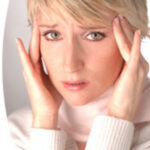I thought I was having my first migraine headache: an aching sensation behind my right ear, sensitivity to light and sound, and a headache throughout the right side of my head. As the day progressed, so did my headache and I started feeling numbness in the right side of my tongue. A few hours later, as I tried to put on my makeup, I noticed that I couldn’t close my right eye. I frantically researched migraine symptoms on the internet and found that numbness in one side of the face was, in fact, a sign of a migraine headache. I breathed a sigh of relief, took some acetaminophen and decided to lie down with a towel over my eyes.
I thought I would wake up the next day with this migraine experience finally behind me, instead, I found the symptoms were getting worse. I still couldn’t open or close my eyelid, and now the entire right side of my face was numb. I couldn’t smile. My cheek wasn’t moving, my eyebrow seemed to be down a little low, my forehead wouldn’t scrunch and I couldn’t move one of my nostrils. I couldn’t overlook the obvious-maybe I had had some form of a mild stroke. I sat down at the computer again and began researching strokes. I had no symptoms of slurred speech or memory loss. Things just weren’t adding up. Maybe I had a tumor. What was happening to me?
My husband contacted a good friend with a medical background and he knew immediately that I had Bell’s Palsy and instructed me to see a doctor. I was back at the computer doing research on Bell’s Palsy and found that I had every symptom of this condition. How could I have missed this? How could this have happened to me? What could have caused this?
Bell’s Palsy: Possible Causes
I consulted several sites on the internet and spoke at length with my doctor. I found that the pain behind my ear was actually a symptom of trauma, in the form of inflammation, occurring in a small tube (fallopian canal) in that general area. This tube houses our 7th cranial nerve (CN-VII), which actually originates in the brain stem and travels to our parotid gland behind our ear. From there it branches out to our neck, face, salivary glands and ear, into over 7000 smaller nerve fibers, and since the inflammation occurs before it branches out, you’re going to lose a lot of functionality. The interesting thing is that it’s happening on just one side of your face, and in fact, this nerve system is mirrored on each side of head and extends to the middle of one side of the face and neck. Bell’s Palsy can occur on both sides of your face, but is rarer.
But what causes this to happen? The inflammation that occurs can be caused by either a viral and bacterial infection or autoimmune disorders such as HIV or even diabetes. Other factors such as stress, which can weaken your immune system, can also lead to Bell’s Palsy. The inflammation within the fallopian canal causes pressure on the nerve and can be caused by the inflammation of the nerve itself and/or our body’s own defenses against a viral or bacterial infection. The inflammation can compress the nerve, damaging it.
Much research has been conducted on the causes of Bell’s Palsy, but I will discuss only the two main causes in this article. The first is the herpes simplex 1 virus (HSV-1), which has been suggested as a cause as far back as 1970. You may be thinking, as I was, there is no way I have this virus! But you would probably be wrong. Most people have been exposed to this virus, and usually at an early age. It is transmitted easily through kissing and other common contact between families. Even if you have never had a cold sore, the most common symptom of the active HSV-1, you may still have come in contact and may be carrying a dormant virus. This dormant virus hangs out on your nerve endings-think back to the 7th cranial nerve we discussed earlier-and resides there until something reactivates it.
Other viruses such as the rubella and mumps virus, which my doctor mentioned to me, are also suspected as the cause of Bell’s Palsy. It is suspected that whatever the virus, the triggers could be a weakened immune system caused by factors such as illness, stress, and even a lack of sleep, or a more serious cause, such as HIV, which weakens the immune system.
Bacterial triggers such as Lyme disease can also lead to Bell’s Palsy and need to be treated as soon as possible to prevent the bacteria from spreading throughout the body.
No matter the cause, you should see a doctor immediately. Medications can greatly increase your chances of a speedy recovery and your doctor will want to rule out any other possible causes for your symptoms. My doctor ordered a CAT scan to rule out tumors and other possible causes, and found that I had a possible bacterial infection in my sinuses. In my case, a round of antiviral medication, antibiotics and prednisone were all prescribed. The use of prednisone (steroids) is a debated topic amongst medical professionals, but the theory is that it aids in healing in combination with the other prescribed medications.
What You Can Expect: The Symptoms
We’ve already discussed the warning signs and some of the initial symptoms, but Bell’s Palsy actually affects your ability to eat, smile and blink among other common functions. The 7th cranial nerve is responsible for sending signals to the muscles of our face that control our facial expressions, but it is only 1 of 12 pairs of cranial nerves. Therefore, you will still be able to see out of the affected eye, but you will not be able to blink. You will be able to move your tongue with both sides, but will lose your taste sensation on the affected side. In terms of your facial expressions, it looks almost like you have had Botox on one entire side of your face. Raise your eyebrows and only one side goes up, and if you’re over 30, so do those lines we all hate, while the other side stays unaffected and clear of any wrinkles or lines. Smile and only one cheek will move – your lips on one side look crooked as they are pulled sideways by your functioning muscles. You will find that drinking out of glass is a challenge-you can’t move your lips on one-side-and using a straw is even harder. You will have to use your hands and fingers to blink your eye, close your mouth and, if you find it necessary, raise your eyebrow.
About that eye, as your doctor will tell you, you need to protect and care for your eye during your recovery. Because you cannot blink, your eye will become dry and possibly itchy. From my own experience, over-the-counter eye drops, “artificial tears” that contain methylcellulose, helped the most. These are different from products for redness-you can apply them as needed-and I needed them frequently. You will also need to tape your eye closed when you sleep (using gauze and medical tape) and you should be sure to wear eye protection when you are outdoors. Since you can’t blink, your eye is always at risk of being hit by a foreign object like dust or leaves and can dry out very easily. You will probably notice sensitivity to the sun as well.
Recovery: How Long Is This Going to Last?
The recovery time for Bell’s Palsy varies and can be anywhere from a week to a few months, or even up to a year. The fastest path to recovery is following your doctor’s orders by taking all of your medications-this is a requirement. The second step is to follow-up with your doctor as needed-you may be referred to a neurologist. The neurologist may teach you special exercises to help you fully recover your facial movements. Keep in mind, most people will recover within 3 months without the need for therapy.
In my own experience, I had a hard time with the initial shock of Bell’s Palsy. Losing half of your facial expressions, the ability to smile mainly, can be a traumatic experience. It’s one of the finer functions of our body, which we undoubtedly take for granted. I worried that I would be stuck with Bell’s Palsy for a year-or possibly never recover. After a couple of days, I realized that the best way to recover was to change my attitude. How bad could it be-really?
As I began to discuss my Bell’s Palsy with other people, I frequently found that either they or someone they knew had it at one time and almost everyone had made a full recovery within a matter of months. I should mention that several of these people had Bell’s Palsy during the last part of their pregnancies. If you’re pregnant, you may be at higher risk for Bell’s Palsy and should talk to your doctor about any concerns. One of the possible causes is excess pressure caused by the increase of fluids or bloating during pregnancy-this can put pressure on your 7th cranial nerve just as inflammation can. Doctors recommend drinking a lot of water and taking it easy on salt to avoid bloating.
Therapy: What You Can Do
The first thing I was told by anyone who has had Bell’s Palsy was to massage my face. I had noticed after a few days that the muscles in my cheek and along the side of my face were very sore. Massaging lightly with my hand seemed to help with the pain and can also help to gently stimulate the nerve threads. You can also apply moist heat to help with any pain you may experience. According to researchers, you need not worry about muscle atrophy during Bell’s Palsy. The facial muscle are unlike other muscles in our body, which may begin to atrophy immediately without use-they believe it could take years for this to occur in our facial muscles. So, take it easy and don’t try to force this part of your recovery. There is speculation of risk of synkinesis, which researchers believe may be the result of abnormal nerve regeneration. An example of this might be that your eye blinks when you smile, for example-so we can actually cause our nerves to heal incorrectly.
Some of the simple exercise you do can do in the mirror are: smiling-try doing this slowly, smiling a little more each time; use your fingers to help you smile from your lips up to your cheeks; practice closing your eye slowly (make sure that you are not rolling your eye upward, but actually closing your eyelid); raise your eyebrows and use your finger if necessary to raise; pucker your lips; practice speaking-especially the letters B and P; massage your face. Speak to your doctor before starting any exercises.
Drink lots of water, get a lot of sleep, take your medications (if prescribed by your doctor), and most importantly, take care of your eye.
My Experience With Bell’s Palsy
To my surprise, exactly one week after the onset of Bell’s Palsy and after I had finished taking my medications, I noticed that my eyebrow was returning to its normal position-this was the first sign of improvement. Several hours later-a tiny twitch in my cheek. I called my sister to tell her the good news-I can move my cheek!
I attribute my speedy recovery to diligently following the doctor’s orders. I set up a written schedule for my medicines, made sure the doses were taken at exactly the right times, and finished every last pill (for the first time in my life-but don’t tell my doctor!). I also made sure to get lots of rest, something that I typically do not do.
Now, almost 3 weeks after the onset of Bell’s Palsy, I have regained almost all of the muscle functions in my face. I still cannot close my eye tightly, but the ability blink is returning and I can smile again-and that’s one thing that I was ready to do. The last thing to return was my bottom lip. It went in this order: eyebrow, cheek, tongue, upper lip, eyelid, bottom lip and peculiarly, nose. I continue to perform simple daily exercise in the mirror to monitor my progress and look forward to putting Bell’s Palsy behind me.
The chances of having Bell’s Palsy more than once are low-researchers speculate that it is under 15%. Knowing the signs and consulting with a medical professional are key to a full recovery.
Reference:
- For more information on Bell’s Palsy search: www.webmd.com or go to www.bellspalsy.ws/



